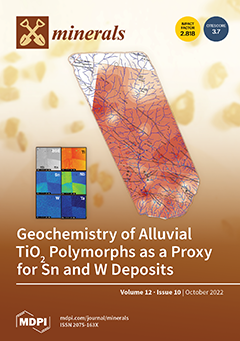Foreland fold and thrust belts always represent a complex diagenetic history of carbonate succession, particularly multiphase dolomitization, due to the multi-sourcing nature of fluids affecting syn-to post-depositional successions. The present work documents a comprehensive study on the diagenetic changes, particularly dolomitization patterns in
[...] Read more.
Foreland fold and thrust belts always represent a complex diagenetic history of carbonate succession, particularly multiphase dolomitization, due to the multi-sourcing nature of fluids affecting syn-to post-depositional successions. The present work documents a comprehensive study on the diagenetic changes, particularly dolomitization patterns in the Jurassic carbonates (Samana Suk Fm) in the Lesser Himalayan fold and thrust belt, NW Pakistan. To better understand the processes involved, integrated field/petrographic, geochemical, isotopic, and micro-thermometric studies were carried out. Field observations indicate that dolostones appear as light grey to brown stratabound and patchy units within the formation. Petrographic analysis reveals that fabric destructive matrix dolomite (RD-I) and fabric preserving replacive dolomite (RD-II) phases are present as distinct units. In addition, saddle dolomite cement (SD) and fracture-filling calcite (CC) are also observed in association with replacive dolomite cement. Geochemical analysis (EPMA) showed that Fe, Mn, and Ba concentrations in matrix dolomite are relatively less than those of replacive/saddle dolomite and fracture-filling calcite, suggesting a hydrothermal source of replacive/saddle dolomite in reducing conditions. Furthermore, stable isotope studies of RD-I showed non-depleted δ
18O values, which represent coeval seawater signatures of Jurassic carbonates. RD shows depleted δ
18O values and non-depleted δ
13C, respectively, indicating burial or elevated temperature of dolomitization. Fracture-filled calcite represents lighter δ
18O values and δ
13C, indicative of relatively high temperatures.
87Sr/
86Sr ratios of all diagenetic phases range from 0.707718 to 0.710747, showing more radiogenic values indicates interaction fluids with more radiogenic sources. Fluid inclusion micro-thermometry data of saddle dolomite shows T
H ranging from 102.8 to 186 °C, and salinity ranging from 11.7 to 19.4 eq. wt.% NaCl, suggesting hot saline brines are responsible for the dolomitization. Fracture-filling calcite shows T
H ranging from 68.0 to 98.4 °C and salinity ranging from 6.9 to 13.1 eq. wt.%. NaCl suggests moderately hot and saline solutions are responsible for their formation. In conclusion, the above-mentioned studies indicate two distinct processes of dolomitization are involved in the formation of matrix and replacive/saddle-type dolomites. RD-I has formed in the evaporative setting, whereas RD has formed due to the interaction of hydrothermal fluids during burial. Fracture-filling calcite is produced from hot subsurface solutions during uplift related to the Himalayan orogeny.
Full article





